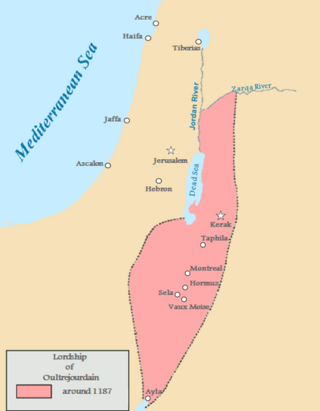
Aimery of Lusignan, erroneously referred to as Amalric or Amaury in earlier scholarship, was the first King of Cyprus, reigning from 1196 to his death. He also reigned as the King of Jerusalem from his marriage to Isabella I in 1197 to his death. He was a younger son of Hugh VIII of Lusignan, a nobleman in Poitou. After participating in a rebellion against Henry II of England in 1168, he went to the Holy Land and settled in the Kingdom of Jerusalem.
Constance of Hauteville (1128–1163) was the ruling princess of Antioch from 1130 to 1163. She was the only child of Bohemond II of Antioch and Alice of Jerusalem. Constance succeeded her father at the age of two after he fell in battle, although his cousin Roger II of Sicily laid claim to Antioch. Alice assumed the regency, but the Antiochene noblemen replaced her with her father, Baldwin II of Jerusalem. After he died in 1131, Alice again tried to take control of the government, but the Antiochene barons acknowledged the right of her brother-in-law Fulk of Anjou to rule as regent for Constance.

There were six major officers of the kingdom of Jerusalem: the constable, the marshal, the seneschal, the chamberlain, the butler and the chancellor. At certain times there were also bailiffs, viscounts and castellans.
The See of Tyre was one of the most ancient dioceses in Christianity. The existence of a Christian community there in the time of Saint Paul is mentioned in the Acts of the Apostles. Seated at Tyre, which was the capital of the Roman province of Phoenicia Prima, the bishopric was a metropolitan see. Its position was briefly challenged by the see of Berytus in the mid-5th century; but after 480/1 the metropolitan of Tyre established himself as the first (protothronos) of all those subject to the Patriarch of Antioch.
The Kingdom of Cyprus, as an offshoot of the Kingdom of Jerusalem, maintained many of the same offices, such as: seneschal, constable, marshal, admiral, Chamberlain, and chancellor.

Aimery or Aymery of Limoges, also Aimericus in Latin, Aimerikos in Greek and Hemri in Armenian, was a Roman Catholic ecclesiarch in Frankish Outremer and the fourth Latin Patriarch of Antioch from c. 1140 until his death. Throughout his lengthy episcopate he was the most powerful figure in the Principality of Antioch after the princes, and often entered into conflict with them. He was also one of the most notable intellectuals to rise in the Latin East.
Opizzo Fieschi, also known as Opizo or Opiso dei' Fieschi, was a 13th-century Italian cleric from the powerful Genovese Fieschi family. Following his uncle Sinibaldo's election as Pope Innocent IV, Opizzo was appointed the Catholic Church's patriarch of Antioch.

Guerricus was the metropolitan archbishop of Petra from 1167 or 1168 until his death at the Siege of Acre in 1190 or 1191. He was the only archbishop of Petra from the Crusader period and its only Latin Catholic bishop from the Middle Ages. Politically, his see belonged to the Kingdom of Jerusalem and roughly corresponded geographically to the secular Lordship of Oultrejordain.
The Roman Catholic Diocese of Sidon was a bishopric in the Kingdom of Jerusalem in the 12th and 13th centuries.
The Roman Catholic Archdiocese of Tyre was an archbishopric in the Kingdom of Jerusalem.
The Roman Catholic Archdiocese of Apamea was an ecclesiastical province of the Catholic Church in the Principality of Antioch from around 1110 to 1149.
William I was the second Latin archbishop of Tyre from 1128 until 1134 or 1135. He was originally from England and served as prior of the Church of the Holy Sepulchre before his appointment as archbishop.

Philip of Tripoli, sometimes Philippus Tripolitanus or Philip of Foligno, was an Italian Catholic priest and translator. Although he had a markedly successful clerical career, his most enduring legacy is his translation of the complete Pseudo-Aristotelian Secretum secretorum from Arabic into Latin around 1230.
John was the chancellor of the Principality of Antioch from 1177 until 1183 and the bishop of Tripoli from 1183 until 1184. He was the archdeacon of the Patriarchate of Antioch during his time as chancellor before he became bishop. His appointment to the bishopric may have been intended as a reward for his years of service, but it may also indicate that he did not wish to serve Prince Bohemond III after the latter's conflict with Patriarch Aimery of Limoges. John briefly held the chancellorship and bishopric simultaneously—signing a charter of Bohemond III in May 1183—but soon relinquished it. He was succeeded as chancellor by Archbishop Albert of Tarsus, who was in office by 1184. He was succeeded as bishop by Aimery by 1186 at the latest.
Latin Diocese of Tortosa in Syria was a Roman Catholic diocese established in the Syrian city of Tartus after the First Crusade. It had a resident bishop between 1128 and 1291. The cathedral of Tortosa became the site of a Marian shrine.

Bartholomew Mansel was the vicar of the diocese of Antioch, regent of Tripoli, and bishop of Tortosa around 1272, a post he held until 1291.

Peter of Limoges was the archbishop of Caesarea from 1199 until his death.
The Lordship of Marash was a territorial lordship in northeastern Cilicia between 1104 and 1149, centred on the city of Marash. One of the lesser Crusader states, it played a major role in the defence of the northern frontier in the 1130s and 1140s under Lords Geoffrey and Baldwin. Its position became untenable after the fall of Edessa in 1146.
The diocese of Marash was an ecclesiastical jurisdiction in eastern Cilicia with its seat in the city of Marash. By the sixth century, it was an autocephalous archbishopric, but it fell into desuetude after the Arab conquest in the seventh century. The archdiocese was never revived.